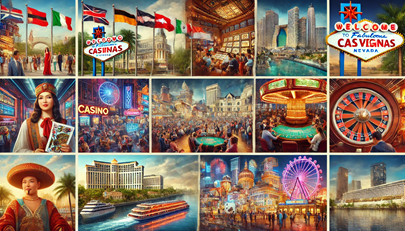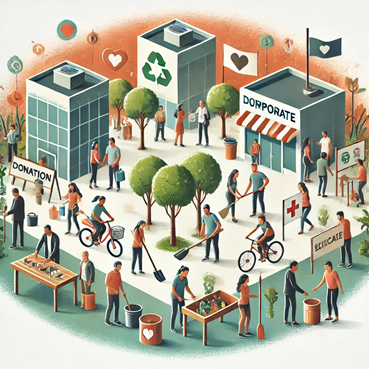What are the benefits of integrating green infrastructure into city designs?

What are the benefits of integrating green infrastructure into city designs?
by Nathaniel 04:08pm Jan 08, 2025
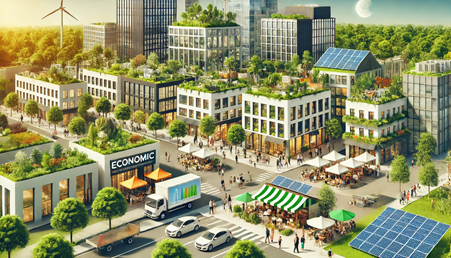
What are the benefits of integrating green infrastructure into city designs?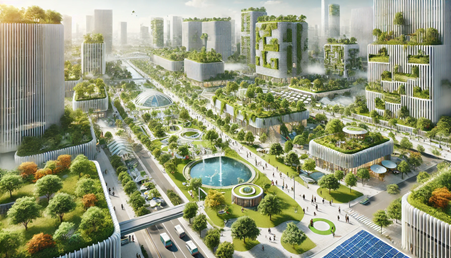
Integrating green infrastructure into city designs offers a wide range of benefits that contribute to environmental sustainability, social well-being, and economic growth. Green infrastructure refers to a network of natural and semi-natural features, such as parks, green roofs, urban forests, rain gardens, permeable pavements, and wetlands, that are designed and managed to deliver ecosystem services. Here's a breakdown of the key benefits:
1. Environmental Benefits
Improved Air Quality:Green infrastructure, such as trees, shrubs, and plants, helps absorb pollutants like carbon dioxide, particulate matter, and nitrogen dioxide.This results in cleaner air and improved public health.
Example:Trees and plants act as natural filters, removing harmful pollutants and producing oxygen.
Stormwater Management:Green infrastructure can reduce the volume of runoff and improve water quality by absorbing rainwater into the ground, preventing flooding and erosion. Techniques like rain gardens, permeable pavements, and green roofs absorb and manage rainwater on-site.
Example:Philadelphia’s Green City, Clean Waters program is a large-scale green infrastructure initiative that aims to manage stormwater runoff through the installation of green infrastructure across the city.
Climate Change Mitigation: Green infrastructure contributes to climate change mitigation by sequestering carbon, lowering urban temperatures, and reducing energy consumption. Urban trees and green roofs provide shade, reducing the "urban heat island effect."
Example:Urban forests help lower temperatures in cities, providing cooling effects that reduce the need for air conditioning in nearby buildings.
2. Biodiversity and Ecosystem Services
Biodiversity Enhancement: Urban green spaces provide habitats for wildlife,supporting biodiversity in otherwise highly developed areas. Urban forests, parks, and gardens can attract birds, insects, and other species that are important for ecosystem health.
Example:Urban areas with well-maintained green spaces, such as Berlin’s Tempelhofer Feld, can host a variety of wildlife despite being in a metropolitan area.
Pollination and Ecosystem Health: Green infrastructure supports pollinator populations like bees and butterflies, which are essential for the health of urban gardens, agriculture, and natural ecosystems.
Example:Community gardens and rooftop farms in cities like New York are increasingly used to support pollinator habitats, benefiting both local food production and ecosystems.
3. Social and Health Benefits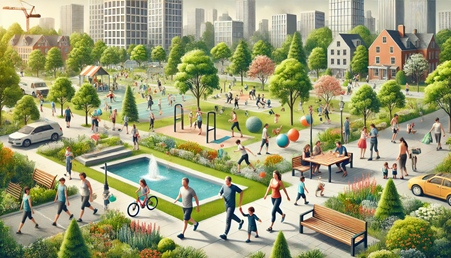
Improved Public Health: Green spaces promote physical activity, reduce stress, and enhance mental health. Urban parks and recreational areas provide spaces for walking, jogging, and socializing, which improve both physical and mental well-being.
Example:Central Park in New York City provides a vital space for recreation and relaxation, contributing to the health and quality of life of millions of urban residents.
Social Cohesion and Quality of Life: Green spaces improve the livability of urban environments by creating attractive, peaceful places where people can socialize, relax, and connect with nature. This fosters community engagement and strengthens social bonds.
Example:Urban green spaces in London, such as the Hyde Park, offer an oasis in a densely populated city, contributing to a sense of community and well-being.
Noise Reduction:Vegetation such as trees and shrubs can reduce urban noise levels by absorbing sound, creating quieter environments that are more comfortable and less stressful for residents.
Example: Tree-lined streets in cities like Paris help dampen noise from traffic, making urban spaces more peaceful and conducive to living.
4. Economic Benefits
Increased Property Values: Properties located near green infrastructure, such as parks or green roofs, tend to have higher property values, attracting residents and businesses who value proximity to green spaces.
Example:Chicago’s Green Roof Initiative has seen significant increases in property values for buildings that have implemented green roofs, as these spaces enhance the aesthetic appeal and offer environmental benefits.
Job Creation and Economic Activity: The installation and maintenance of green infrastructure creates jobs in sectors such as landscaping, horticulture,architecture, and construction. It can also boost local economies by attracting tourists and new businesses.
Example:London’s Green Infrastructure Plan has not only contributed to environmental sustainability but also created jobs in urban gardening,landscape design, and construction.
Energy Savings:Green infrastructure can reduce the need for air conditioning in the summer by providing shade and lowering surrounding temperatures. This translates into lower energy consumption and reduced utility costs for residents and businesses.
Example:Green roofs in Berlin and Chicago have been shown to reduce building energy costs by improving insulation and cooling, saving money on heating and cooling bills.
5. Resilience to Climate Change and Natural Disasters
Flood Mitigation:Green infrastructure helps manage excessive rainfall, reducing flood risks by promoting the infiltration of rainwater into the ground and providing storage for stormwater. This is particularly important in cities with high rainfall or those facing increasingly intense storms due to climate change.
Example:New York City’s green infrastructure has been crucial in mitigating the impacts of flooding from heavy rain, particularly in flood-prone areas.
Adaptation to Extreme Heat: As cities become hotter due to climate change, green infrastructure provides natural cooling mechanisms. Trees, green walls,and other forms of vegetation help moderate temperatures and create cooler microclimates.
Example:Melbourne, Australia, uses green roofs and urban trees as part of its strategy to combat extreme heat, reducing the impact of urban heat islands and improving overall comfort in the city.
6. Aesthetic and Cultural Value
Enhanced Urban Aesthetics: Green infrastructure improves the visual appeal of cities, making them more attractive and pleasant places to live and visit. Aesthetic landscapes, such as green walls or tree-lined boulevards, can transform urban environments into more inviting spaces.
Example:Singapore’s Gardens by the Bay is a prime example of green infrastructure that has transformed the city into a global tourist attraction while enhancing its beauty and livability.
Cultural and Recreational Spaces: Urban green spaces also provide areas for cultural activities, festivals, markets, and other social events, contributing to a city’s cultural vitality and creating a sense of place and belonging.
Example:Buenos Aires incorporates green plazas and parks that serve asspaces for cultural gatherings and public events, enriching the city’s social fabric.
Conclusion
Integrating green infrastructure into urban designs offers numerous benefits, including environmental improvements, social well-being, economic growth, and climate resilience. From enhancing biodiversity and managing stormwater to reducing air pollution and fostering healthier, more vibrant communities, green infrastructure plays a critical role in building sustainable cities. As cities around the world continue to grow, incorporating green infrastructure can help create more livable, adaptable, and resilient urban environments.




